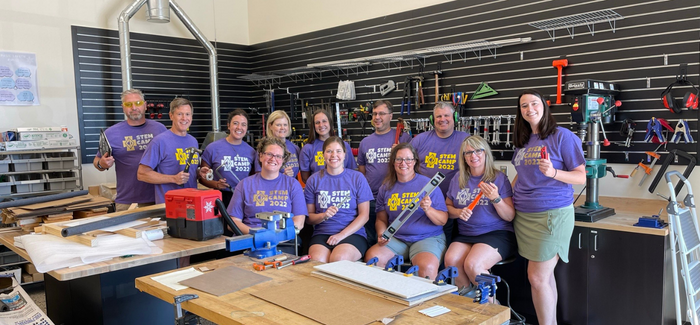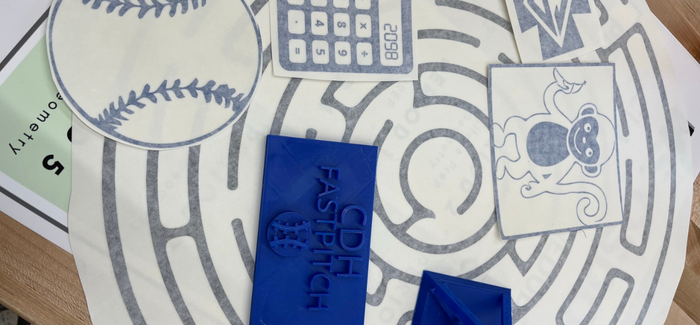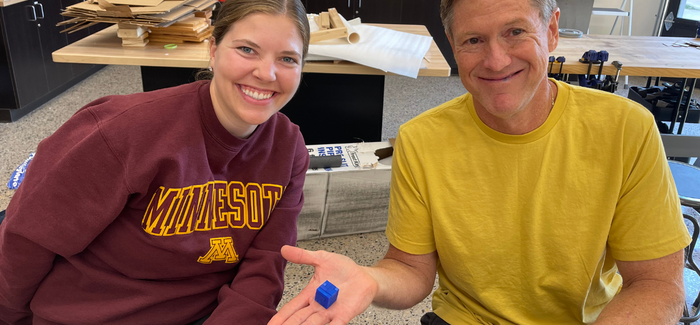Summer Teacher Academy Strengthens Curriculum with the STEM Center
Greta Cunningham ’23, Communications Apprentice
August 18, 2022

This year, the first week of August was dedicated to Cretin-Derham Hall’s second 2022 Summer Teacher Academy, a CDH tradition where teachers collaborate to design a developmental program they value and receive a stipend to attend. While June sent eight teachers to El Paso, Texas and Chihuahua, Mexico for the El Otro Lado or “The Other Side,” justice education trip to learn more about immigration and border relations, August had over ten teachers exploring right on campus in a new academy: Incorporating Teacher Curriculum into the Ryan STEM Center.
“Now that more teachers know how to use the space, more students will be able to utilize all the machines in the space and learn essential 21st century skills,” said Ellen Schafer, former STEM coordinator, now science teacher, who instructed the academy with David Sobolewski of the technology department.
The academy started by introducing teachers to specific software and machines with individual or group training and one-on-one assistance resulting in visceral products daily. Each day ended with the opportunity for teachers to discuss how these skills and resources could be incorporated into their curriculum.
“Participating in this Teacher Academy will allow me to learn how to use a variety of machines and tools present in the Ryan STEM Center and collaborate with my colleagues to build material for our classes that promotes deeper learning through this space,” said Frances Weyrauch, a participant from the science department.
This professional partnership is an essential part of the academy’s appeal to teachers as an opportunity to strengthen the connections between educators and across departments. The August academy had teacher involvement from the math, science, social studies, and world language departments.
“Teachers are always motivated to revamp activities or develop new learning opportunities for students. The academy allows us this space to work on our curriculum to improve the experience students will receive in our classrooms,” said Weyrauch.
The academy introduced and reviewed several distinct programs, such as OnShape, Canva, Roland CutStudio, Adobe Illustrator, Photoshop, and Universal Control Panel. Teachers then learned how to bring the designs they created on these platforms to life with 3D printers, a large format printer, vinyl cutter & cricut iron-on press, and laser cutter. Teachers were also trained to use the general construction tools housed in the STEM Center, such as a panel saw, drill press, band saw, and sander. Finally, teachers worked with the Virtual Reality System in theVR classroom.
“My favorite part of the academy was learning about Adobe Illustrator and then using the laser cutter. I hope to use the STEM Center/Design Room at least once each trimester for each class that I teach,” said Michael Steineman ’92. “I am looking forward to using the engineering design process more often in all of my classes and inspiring my students to be creative.”
The STEM Center continues to inspire teachers to expand the ways they connect with their students and their students connect with their curriculum.
“Many students find stronger learning occurs through the stimulation of multiple intelligence learning. The Ryan STEM Center allows students to channel these various intelligences through the ability to be creative, work with hands-on materials, collaborate with peers, and engage in growth through improvements to a product they develop,” said Weyrauch.
Multiple Intelligences and Learning Styles (MILS) is an educational philosophy integral to CDH’s teaching style. MILS identifies nine areas of intelligence — naturalist, logical-mathematical, linguistic, interpersonal (people-smart), interpersonal (self-smart), spiritual, bodily-kinesthetic, spatial, and musical — and encourages teachers to use all nine in the classroom, while guiding students to discover their strengths and the accompanying study techniques that can help them across subjects. The STEM Center is a powerful way to diversify how students engage with their curriculum.
“My favorite part of this academy was working with 10 enthusiastic teachers who learned so many new and valuable skills that can be directly integrated into their 2022-2023 curriculum,” said Schafer.
The teachers look forward to a school year filled with innovative learning strategies, the expansion of their skills and being more comfortable with the tools the STEM Center has to offer.



